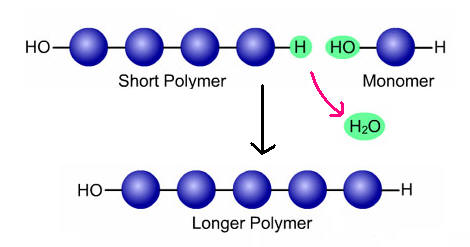 CARD
REVIEW (We did this in class)
CARD
REVIEW (We did this in class)Fill in the blanks on your answer sheet.
 CARD
REVIEW (We did this in class)
CARD
REVIEW (We did this in class)
Fill in the blanks on your answer sheet.
|
1. Name this molecule which has a polar head and two non-polar tails and is used to make cell membranes.
|
http://asm.wku.edu/pix/cells/P-lipid2.gif
|

2. Molecules (like lipids) that are “water fearing” and try to stay away from water and other polar molecules are called ___________________.
3. Organisms like green plants that can get their energy by making their own food are called ________________.
4. A “living thing” can also be called an ____________________.

|
5. Name this molecule.
6. Tell the function of the molecule at the right.
|
7. The nitrogen base that is NOT found in RNA is _______________.
Adenine Guanine Cytosine Thymine Uracil
8. The process in which cells change as they grow to become different kinds of cells with different functions is called _________________.
9. Type of reproduction in which genetic material from two parents is combined to produce offspring.
10. The sum of all the chemical reactions that build up and break down molecules in cells is called
_____________________.
11. Cells always try to maintain a stable internal environment. This is called ____________________.
|
12. Which of the following molecules could you join together to make a polysaccharide?
|
 A |
B |
 C |
 D |
![]() Phospholipid,
nucleotide, aminoacid images by Riedell:
Phospholipid,
nucleotide, aminoacid images by Riedell:
Glucose Image from: http://www.estrellamountain.edu/faculty/farabee/biobk/BioBookCHEM2.html
13. A molecule with an uneven distribution of electric charges (more positive on one side and more negative on the other) is called ____________.
|
14.Which of the molecules at the right is an amino acid? |
 A |
 B |
C |
 D |
15. The subunits used to make proteins are ________________.
Amino
Nucleic Sugars lipids nitrogen
acids acids bases
|
16.Which of these molecules could you use to build a DNA molecule? |
 A |
 B |
C |
 D |
17. Animal cells store glucose as ________________.
starch glycogen cellulose glycoproteins ATP
18. DNA and RNA
are both_________________________.
Amino Nucleic carbohydrates lipids proteins
acids acids
19. The science that studies all living things is called ___________.
|
20. Water is a ________ molecule. Polar non-polar
|
http://www.lsbu.ac.uk/water/molecule.html
|
|
21.
This type of chemical reaction is called ________________.
(HINT: Look what is happening...
|

http://www.usd116.org/apalla/biology/unit3/notes/3notes1.htm
|
22. Humans are _________ _________.
unicellular autotrophs
OR OR
multicellular heterotrophs
#23.
#24. #25.
Name 3 characteristics shared by all living things.
26. The chemical symbol for a potassium ion is ____.
27. The changing
of a population of organisms over time is called______________ .
28. The protein molecule in red blood cells that carries oxygen is called ________________.
 Image from: Biology Pearson Prentice Hall © 2006 |
29. Name D in this diagram showing an enzyme catalyzed reaction. |
|
30. If this molecule was used to make RNA tell one of the nitrogen bases that could be used here. |
à
Image by Riedell |
31. ______________ is the opposite of dehydration synthesis.
32. Which part of a phospholipid is polar? Head OR Tails
ANSWERS
1. phospholipids
2. hydrophobic
3. autotrophs
4. organism
5. glycoprotein
6. helps cells recognize "self"; cell identification
7. Thymine is not found in RNA
8. differentiation
9. sexual reproduction
10.metabolism
11. homeostasis
12. D (glucose) could be used to make polysaccharides
13. polar
14. B is an amino acid
15. Amino acids are used to make proteins
16. C is a NUCLEOTIDE used to make nucleic acids (DNA & RNA)
17. glycogen
18. DNA & RNA are nucleic acids (that's what the NA stands for!)
19. biology
20. water is POLAR
21. dehydration synthesis
22. multicellular heterotrophs
23-25. Made of cells
Reproduce
Contain universal genetic code
Grow & develop
Respond to their environment
Obtain and use materials and energy (metabolism)
Maintain stable internal conditions (homeostasis)
As a group, change over time (evolution)
26. K+
27. evolution
28. hemoglobin
29. enzyme-substrate complex
30. A, U, C, or G can be used to make RNA
31. Hydrolysis is the opposite of dehydration synthesis
32. The head is polar